Southeast Asia on 2 Wheels
We just returned from a bike trip from Vietnam to Cambodia, as a part of our month-long trip in the region. Read about how we planned and prepared for the trip here. Read about our first few days in Vietnam here.
We found and booked a 9-day bicycle trip to Vietnam and Cambodia with Art of Bicycle Trips before the pandemic. This is a top-notch company which I highly recommend! After numerous postponements, we finally made it to Vietnam for our 9-day bicycle trip through southern Vietnam, straight up the middle of Cambodia, ending in Siem Reap, home to Angkor Wat. We booked the “Saigon to Angkor Premiere Bike Tour.” This trip cost around $3000 per person and included most meals, accommodations, bikes, guides, and support. For around $2000, you can do a very similar tour and stay in “Casual Inns,” Which I am sure are lovely and charming.
Art of Bicycle ranks their trips according to difficulty, with levels including easy, moderate, and challenging. This one was ranked as easy. Art of Bicycle offers trips ranging from 4 to 14 days in several countries, with a focus in Asia. The company was started in India, and the selection of tours there is abundant. Some trips incorporate other sports such as hiking and kayaking.
Accommodation on our bike trip from Vietnam to Cambodia
Art of Bicycle Trips has two levels of accommodation- Casual Inns and Premiere Inns. As the name of the tour says, we stayed in premiere inns. These were some of the nicest hotels we have ever stayed in and included two Victoria brand hotels and two Raffles. Despite being major international chains, each maintained local flavor and personality. The independent hotels we stayed in, Mekong Riverside Resort and Sambor Village, were enchanting.
Bike Trip from Vietnam to Cambodia – Day One
Day 1 was at leisure until 5:00 pm. The evening consisted of a briefing with our guide, a bike fitting, and dinner. Our hotel for the first evening was the Hotel Des Artes Saigon, and it was just lovely. Phuc, our guide for the Vietnam portion of the bike ride, met us in the lobby and outlined the process.
Our group consisted of my friend Allison, her hubby Sam, their 5-year-old son Sammy, and Allison’s dad Dean. Their groups range from 2-14 people, but somehow we ended up with a private tour! Note- you can arrange a private tour if you cannot find a date or itinerary that works for you. There may be a slight upcharge depending on how many people you have and what your specs are, but it is not exorbitant.
Bike Trip from Vietnam to Cambodia – Bikes
Our van took us to the suburbs of Saigon for our bike fitting. The equipment was new and in top working order. The bikes seemed brand new and were very high-end. They use Cannondale, Giant, Specialized, and Bianchi. We opted for the e-bikes. The ones we had in Vietnam were retrofitted and in Cambodia, the e-motors were built in. Both had amazing pep and the e-assist helped out greatly. There was an extra surcharge of $200 for an e-bike, but it was well worth it to have that little boost when needed. You can always turn the e-assist off if you want to work harder. They have attachments if you want to take your kiddo along, just be sure to arrange this ahead of time. Our friends brought their 5-year-old and he did great.
They gave us awesome bike jerseys with the company’s logo, which had several pockets. Perfect for holding our cell phones! They also provided little bags that were attached to the bikes and were big enough for the essentials we needed for the day.
Dinner was mediocre at a tourist-heavy restaurant with no ambiance whatsoever. I don’t remember what it was called, but that’s probably best. The rooftop bar at the Hotel Des Artes, the Social Club, is touted as one of the best in the city. We were not up for drinks, but we checked it out and it was chic and hip, with panoramic views of the city.
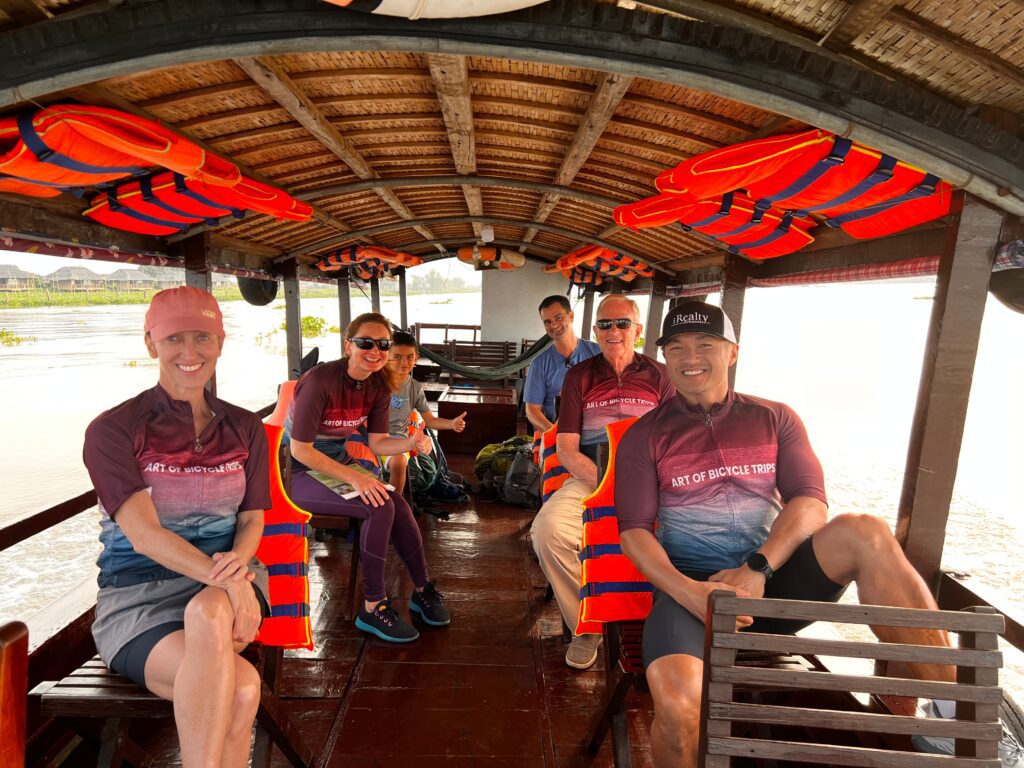
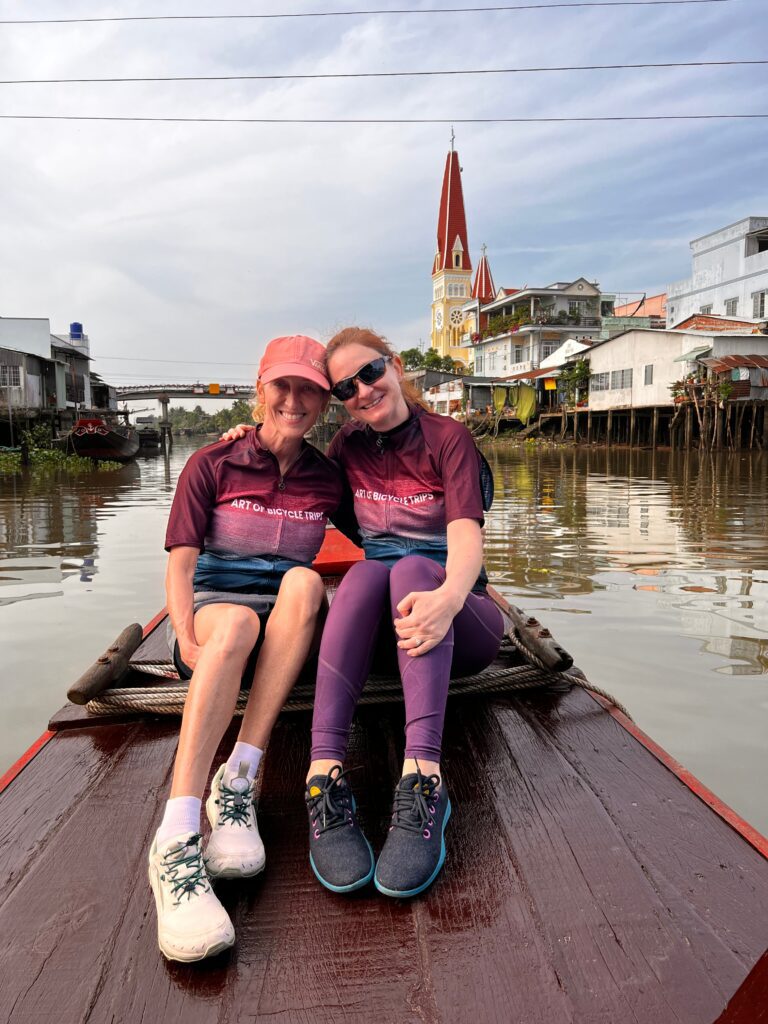
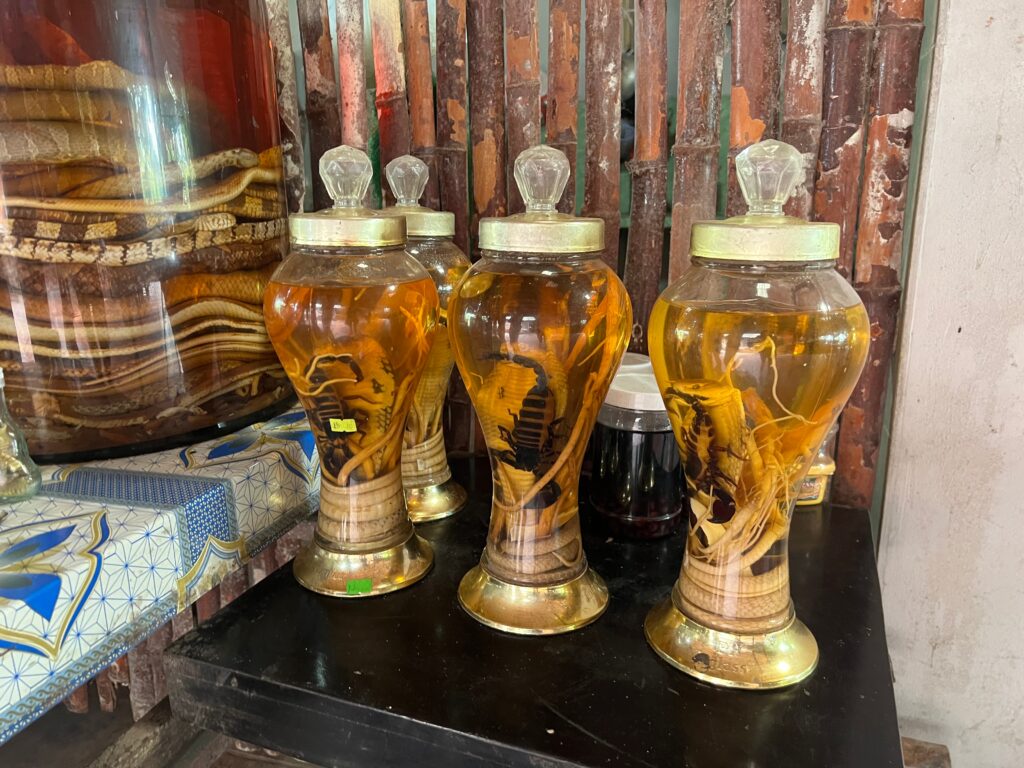

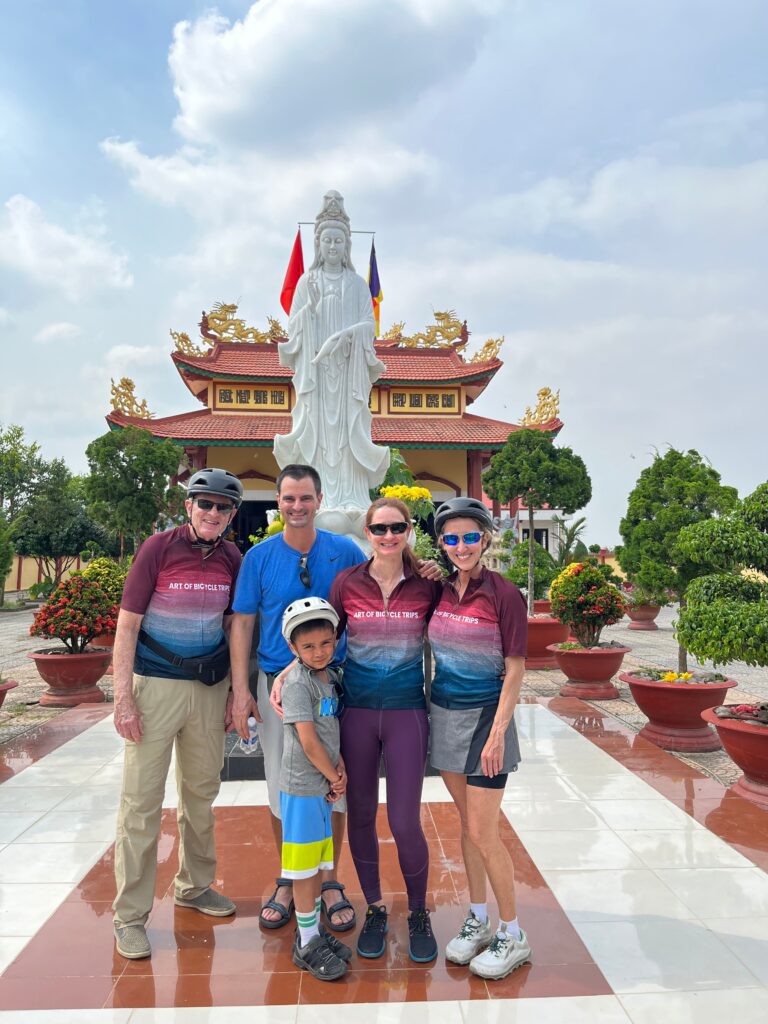
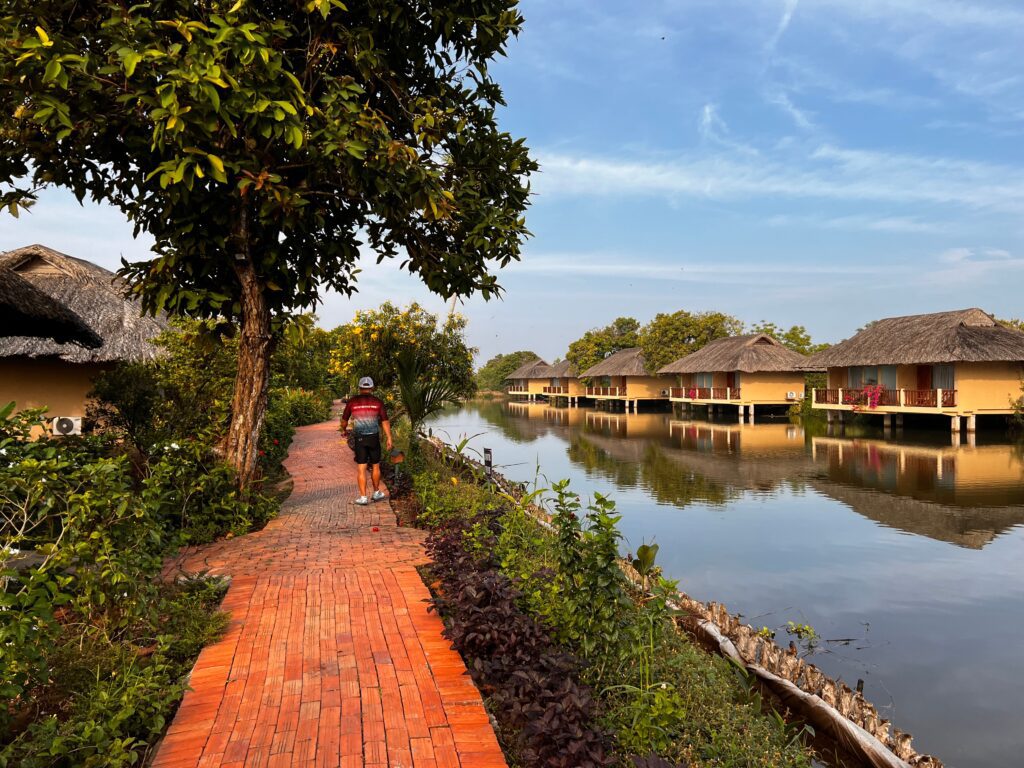
Bike Trip from Vietnam to Cambodia – Cai Be
The second day listed on the itinerary was the first day of biking. Unfortunately, Vuong and I woke up sick as dogs. The others did not get sick, so maybe this was food poisoning from our adventurous eating in Saigon, but I still blame the previous night’s dinner. It doesn’t really matter, in my mind. We are careful about what we eat, but we are not obsessed and we are not germaphobes. I usually end up sick for a day or two when we are traveling…
Allison and her family raved about the breakfast buffet at the Hotel des Artes. It was a glorious spread with many Western and Asian options.
Each day had a certain amount of shuttle time in the van. On this first day of biking, Vuong and I just could not do it. So, we dropped off the rest of the group to start pedaling and had the driver take us directly to Mekong Riverside Resort. Art of Bicycle Trips was so accommodating and flexible and really bent over backward to take care of us. They arranged an early check-in and we stayed in bed all day and all night.
Mekong Riverside Resort
What a magical place to spend a day, though. This resort was gorgeous. Right on the banks of the mighty Mekong River, it consists of 25 freestanding bungalows, each of which contains two rooms. 10 are directly on the river and the rest on a tributary. Boardwalks lined with colorful flowers lead to the rooms, and fishing poles and kayaks are available at no charge. There is a spa and a restaurant. If you have time, the resort can arrange day trips for you.
We couldn’t enjoy any of the perks or amenities, but the bed was comfy and we could watch life on the river from our window or balcony. Between us and the river was a long strip of water hyacinth, which helps prevent erosion on the shoreline and provides a habitat for fish. This can be an invasive plant, but it also has numerous uses including food, crafts, and fertilizer.
Our room had a stocked mini-bar, snacks, and high-end toiletries. Allison and her family reported back that dinner was excellent and the fishing was not! Breakfast was quite a spread, consisting of fruit, bacon and eggs, bread, and banana milkshakes (yummmm what a treat!).
Bike Trip from Vietnam to Cambodia – Can Tho
After breakfast, we took a boat ride along a small portion of the river and its tributaries. In Vietnam, the Mekong River is known as “Cuu Long,” the River of Nine Dragons. It is over 3000 miles long and traverses parts of Tibet, China, Myanmar, Laos, Thailand, Cambodia, and Vietnam. Along the way, it picks up water from innumerable tributaries and drains the land in the river basin. By the time it reaches Cambodia, it has gained about 95% of its flow and is deep and wide. There is seasonal variation, and the river delta often floods.
The Mekong Delta is the part of Vietnam that surrounds the river as it makes its way to the South China Sea, and the area is largely settled villages and farmland, to make use of the abundant resources granted by the river.
Coco Home
We stopped at a family-owned market called the Coco Home, near Cai Be town on the Mekong River, where they make various items out of rice. Rice is the lifeblood of this area and a staple of the Vietnamese diet. Here, they make rice paper, rice wine, puffed rice, and coconut candy. Rice paper is used for wraps, noodles, and dumplings, to name a few. Rice wine is a popular beverage in the area, and there were bottles on display containing fruit, scorpions, and snakes!
I had never really thought about where puffed rice came from. This popular base for cereals and candy is made in a giant wok. Raw rice and black sand are rapidly heated and constantly stirred. Eventually, the rice starts popping like popcorn and, voila, you have puffed rice! The chef then sifted out the sand and added flavors to the puffs!
You can purchase handmade coconut candy, puffed rice, rice wine, and numerous other drinks and snacks. I recommend the ginger candy- it is great for treating nausea, and I always keep some on hand to chew on when my tummy acts up.
Biking through the Mekong Delta
Vuong was still feeling ill, so our driver dropped us off at the start point and took him straight to the hotel, Victoria Can Tho.
The bike ride was easy, particularly with the e-assist. The paths were mostly paved, much like sidewalks, for this part of the trip. There was very little motorized traffic, most of which was in the form of motor scooters. There were 6 of us, and we stayed together pretty well as a unit. I felt very safe for the entire ride and hardly worked up a sweat. With e-assist, each pedal not only gives you the energy that a normal pedal gives but there is an extra boost with each stroke. I kept my setting on “1” for most of the ride, using “2” only to climb the few hills and bridges we crossed.
It was essential to hold your brakes after stopping until you turned off the bike, or you could have a runaway bike on your hands!
If you are not super fit and/or not used to biking, don’t worry! The “easy” trips are truly easy. Not to mention that your group is accompanied by a support van which you can hop in at any time. Biking is such a great way to really see a place! When riding in a vehicle, you speed by so many places and are separated by glass and metal. On a bike, you really get close to the people. You take in not only sites but smells and sounds as well!
If you are considering such a trip and are nervous or have questions, please message me! I will answer any questions you might have!
The Ride
We rode along waterways and rice paddies, through villages, and across the countryside. We passed through banana and bamboo groves. Roosters’ crows punctuated the background noise of everyday life. Now and then, we would hear twangy Vietnamese music and a loud, warbling voice belting out karaoke. Not quite ready for Paris by Night (IYKYK)! In some areas, fragrant, colorful flowers lined the road. In others, there were dragon fruit farms.
The villages consisted of paved paths lined by largely open-air houses, giving us a peek into real village life. We could see women squatting doing the laundry, men lounging in hammocks, and kids playing. Our passage often startled people, and the kids would run out waving and saying “hello!” Sam had a pull-behind carrier/trailer for Sammy, which elicited riotous laughter from many people we passed.
There were VERY few tourists on our route. We really got off the beaten path and into real life. The weather was perfect. It was warm, but not hot. Being on the bicycle added a breeze, and it was delightful. The exhaust fumes of the city were gone and replaced with fresh air, scented by flowers and occasional grilling meat.
Highlights
Highlights of today’s ride included coffee and snacks with Vietnamese Bruno Mars, this oddly flamboyant guy who really wanted me to take his photo. Repeatedly. Then, we were riding along somewhere in Vinh Long province and heard raucous laughter and loud music. We had come upon a wedding! It was around 11:00 in the morning, but the guests were already well into their cups! Guests ran out to greet us and invited us in, offering the men beer and the rest of us yogurt. We got a pic with the beautiful couple and said our goodbyes.
After hot pot lunch by a lotus pond, we visited two different types of Buddhist Temples and learned a bit about the religion’s role in Vietnamese life. One of the temples was tucked away in a residential neighborhood and is better described as a temple complex. It was peaceful and smelt of incense. The complex consisted of several buildings decorated with gold and ornate carvings. Monks were building yet another pagoda in the back as part of their commitment to give back to the community.
Victoria Can Tho
This gorgeous hotel with French Colonial architecture is situated on the river, within walking distance of the lovely town of Can Tho. Victoria Can Tho was ornate and pristine, and the hostess greeted us with ice-cold fruit juice and escorted us to our rooms. The decor was done in teak wood and warm, rich earth tones. You could see straight through the open-air lobby to the two massive pools surrounded by a manicured lawn and garden.
Our room was decorated similarly and had a king-sized bed outfitted in white linens and a balcony overlooking the pool. All of the rooms we stayed in had filtered bottled water, fresh fruits, and a mini-bar with snacks (for a fee).
Dinner was a feast of various Vietnamese dishes. The dinners tended to be multi-course feasts of egg or spring rolls, soup, salad (green papaya, morning glory, or something similar), meats, and dessert. I really did not care for this- it is too much food, all the dishes tended to be similar, and we preferred to make our own choices. I understand- they are trying to cater to a range of tastes and save time. But, we tend to prefer street food or a casual one-course meal.
We loved the town of Can Tho!! It is the 5th largest city in Vietnam, behind Saigon, Hanoi, Hai Phong, and Da Nang. It is a wealthy city, and it flaunts that wealth in the form of a million neon lights decorating the city! The night market was vast and bustling, catering more to locals than tourists. We strolled around, bought some souvenirs, and walked back to the hotel over a brightly lit pedestrian bridge then on a trail by the river.
Cai Rang Floating Market
The hotel breakfast was a magnificent spread. I opted for pho, a popular Vietnamese soup often consumed for breakfast in the country.
Durian
We boarded a boat to visit the Cai Rang Floating Market. But first…there was a lady selling durian by the dock, and Sam was keen to try it! Durian is also known as “stinky fruit,” and most people who try it love it or hate it. Vuong and I hate it. Phuc bought a baggie of it for Sam to try, and we boarded the boat.
Sam enjoyed the first bite. Something happened between bite one and bite two that altered his perception of this fruit forever! He spit out that second bite and almost vomited over the side of the boat! Phuc was more than happy to slurp down the rest, much to Sam’s disgust! Mushy, cheesy, decaying onions… wanna try??
The Market
As we entered the trafficked area of the Cai Rang floating market, Phuc picked up the microphone and took the stage. He told us about the history of the market and how people would come from miles away and sleep on their boats to prepare for market day. Each boat has a specialty, and you can tell what that is by what they have hanging on a large pole. He called on the “supermarket,” because it had several different fruits and vegetables.
Many of the boats were anchored, but a few floated around. The latter tended to be the snack or coffee boats that would sell their wares to the shop owners. Most of the boats were old, wooden, and ramshackle. This market sold only produce and food items, from sweet potatoes to watermelons to lychee, not clothing or household goods. The men tend to do the manual labor- driving the boats, working the fields, mechanical repairs, etc. We rarely saw this- most of the men we saw lounged in hammocks playing on their phones and smoking cigarettes. Meanwhile, the women did business.
It was an interesting peek into real daily life. We disembarked on some old railroad ties and walked down a busy road with numerous meat markets, back to the van.
Bike Trip from Vietnam to Cambodia – Chau Doc
Our final day of biking in Vietnam commenced soon after. Vuong was finally feeling better, so our group was complete! Everything is so much better with him! I love his commentary and inquisitive, gregarious nature. Today was similar to the previous day, with our route taking us through numerous small villages and towns. We had a little time on a road with traffic, which was a bit harrowing. But that was only about 10 minutes or so.
One of my favorite parts of the bike was today- a long, straight paved road flanked by yellow bells and palm trees, which led us through rice paddies and banana plantations. Such a beautiful country! After visiting a wood sculptor, our van picked us up and took us to Chau Doc for Banh Xeo. The group enjoyed watching the ladies making these Vietnamese crepes, then we enjoyed gobbling them down!
One thing about Vietnamese food is that they love adding herbs and leafy greens to everything. You get a large plate of basil, mint, bean sprouts, and other leaves/vegetables with your pho. Spring wraps have leaves inside. Banh xeo comes with a stack of lettuce leaves, which you tear off and wrap around each bite of the crepe. I love this- the flavors and texture the greens add is unique. The problem is, the vegetables are washed with water, and we are not supposed to drink the water. There are often bacteria or parasites that our immune systems are not prepared for. So, be careful when traveling overseas! Salad can be dangerous! Ask, because some upscale places wash their veggies with filtered water.
Victoria Chau Doc
Tonight’s accommodations were at Victoria Chau Doc, on the banks of the Song Hau River, a branch of the Mekong. The hotel was a picture of French Colonial architecture in yellow and white, again decorated in teak wood and warm earth tones. Our room was, again, gorgeous and well-appointed.
We said goodbye to Phuc here, and were sad to see him go! He was an excellent, knowledgeable guide and a patient, sweet man. He held our hands from moment one and then turned us over to an interim guide at Chau Doc.
After a hand and foot massage, I went to bed early while the others had a nice dinner. Breakfast was, again, a feast of Asian and Western cuisine!

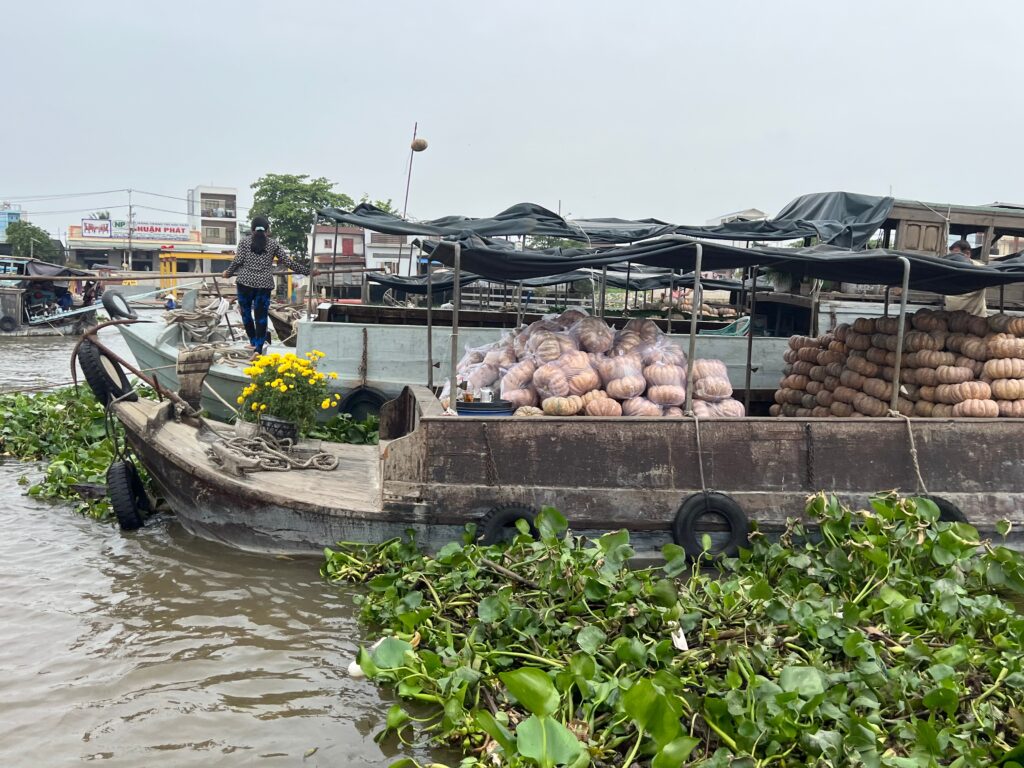


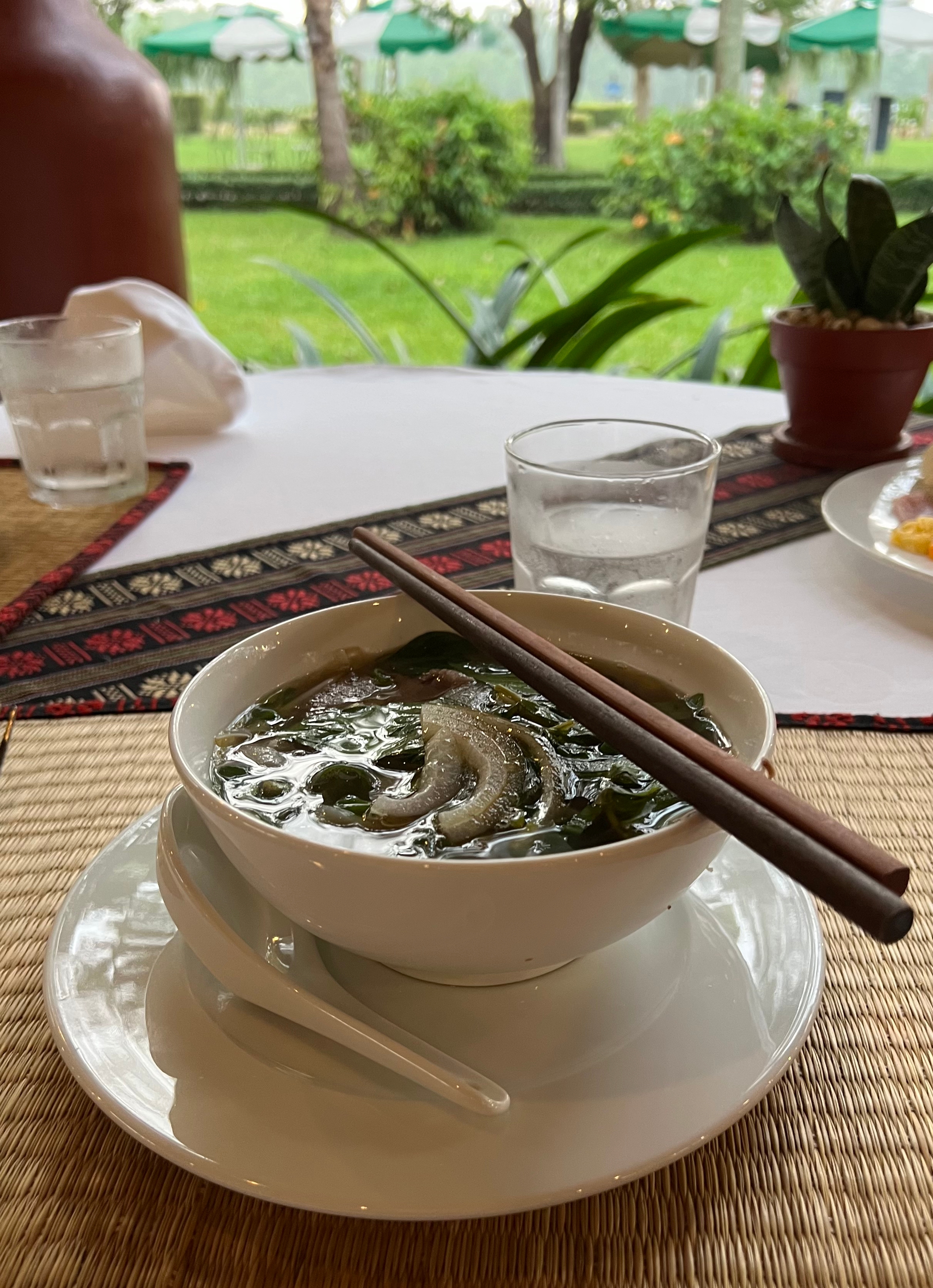
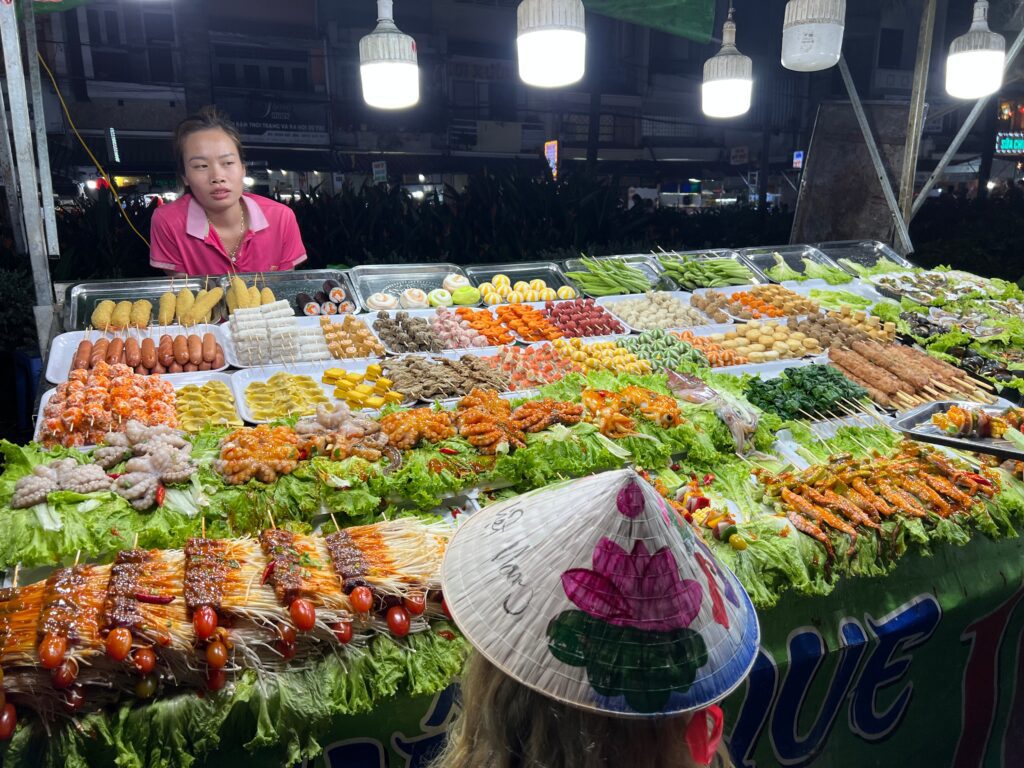
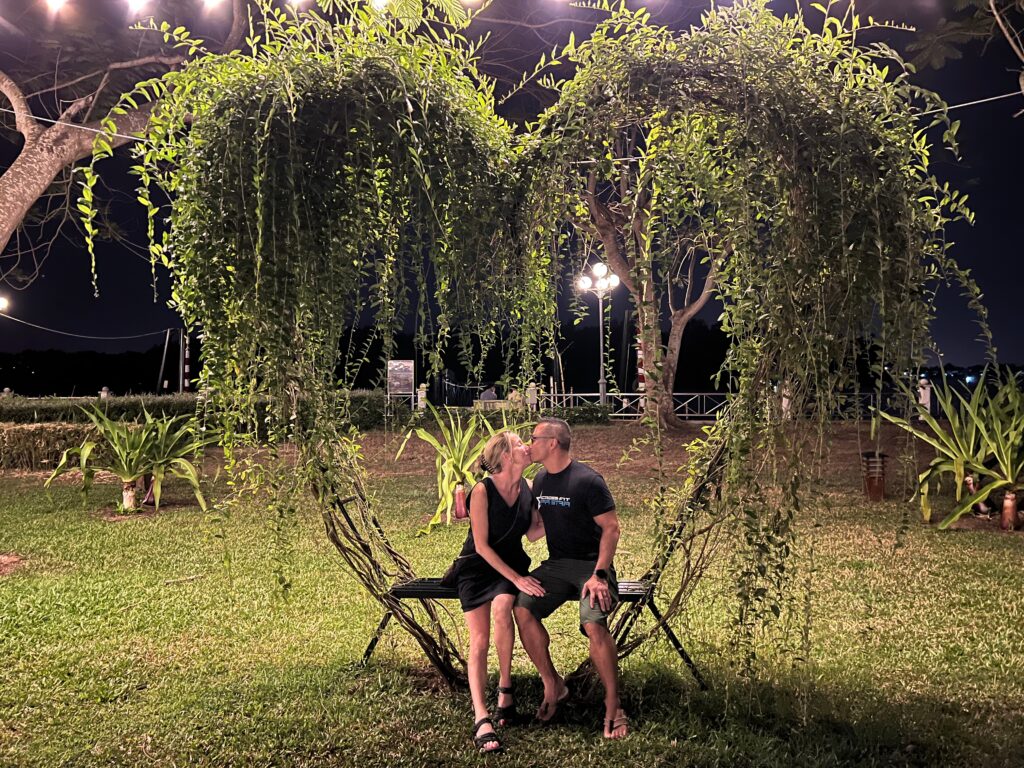
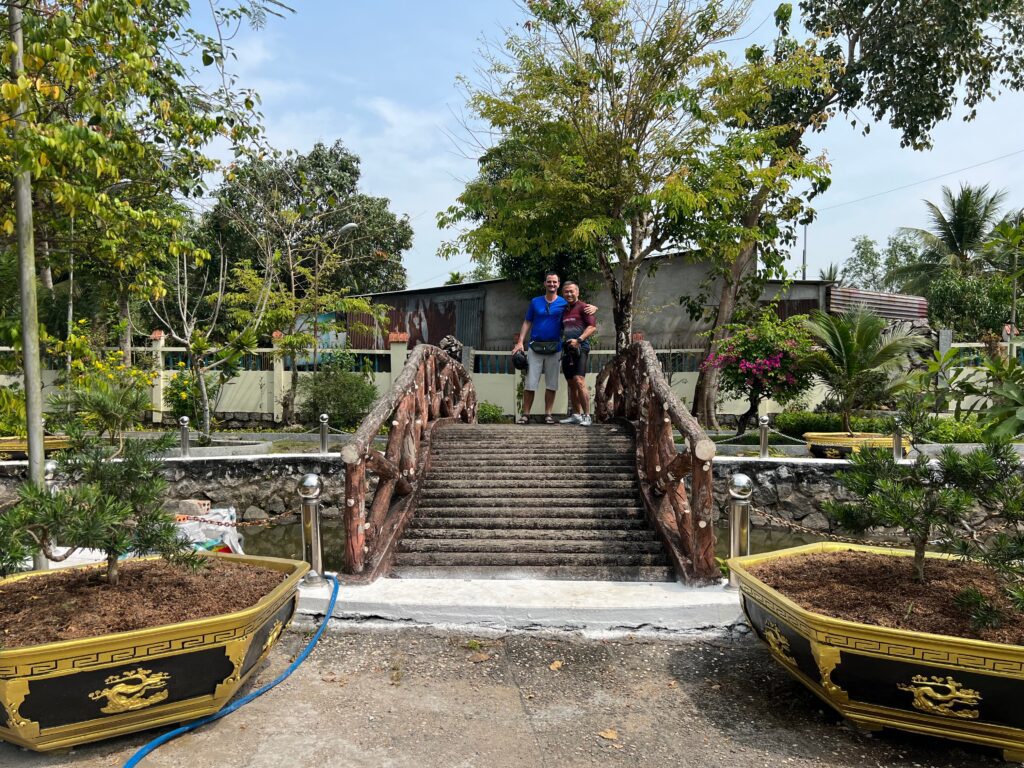
Boat Ride to Cambodia
A line of tourists filed onto the pier, and I was worried that we were going to be stuck on a crowded, hot boat with a bunch of smelly tourists for 5 hours. Our guide took us onto a small boat with wooden benches lining its sides, and my sciatica started flaring up just anticipating the journey. Then, he led us through that boat onto another boat! Oh yes, this was much better!
There were 6 leather captain’s chairs in the passenger cabin, one for each of us. Our boat driver gave us cool towels and bottles of water, offering up coffee and snacks as well. Ah yes, I could handle this!
After a short ride down the Song Hau River, we entered the Mekong and the captain opened it up! We sped down the river, watching homes and fields go by. Now and then, we would spy on a cow or buffalo. Occasionally, kids would run out to the river and wave at us.
Along the way, there were huge, flat ships dredging up sand from the floor of the river to use in making concrete. The effects of this were obvious in the form of shore erosion which resulted in many houses falling into the river. To counteract this, the water hyacinth would be allowed to grow, and retaining walls were built. Dredging is a major operation in this area and seems counterproductive to me.
Border Crossing
After an hour or so, we stopped to cross the border into Cambodia. We had to stop on the Vietnam side to show our E-visas, then again on the Cambodia side. The latter was a long process and we had to hang around for a while. The immigration area was like a small motel and had several spirit houses. Spirit houses are placed outside of homes or businesses. They are cute little mini-houses where Asian Barbie might be very happy. Offerings are left here to either appease spirits to prevent them from harassing the residents of the home or to ask them for protection.
The area was decorated with gorgeous flowers and stray dogs milled about. After a long wait, we received our visas on arrival, added a Cambodian flag to our boat, and boarded for a couple more hours’ ride to Phnom Penh.
Bike Trip from Vietnam to Cambodia – Phnom Penh
The capital of Cambodia knocked our socks off! It is a clean, cosmopolitan city with amazing sites, a plethora of international cuisine, and innumerable activities. You could easily (and cheaply) spend a week, or even a month, here! We would love to really get into this town!
As it were, we only had one night. So we made the most of it. Of course, Art of Bicycle Trips had arranged everything, and the transition went smoothly. Back in Chau Doc, Phuc turned us over to our guide for the boat ride who, along with our boat driver, led us through both immigration stops, gave us some info along the way, fed us snacks, and then turned us over to our guides in Cambodia.
Half-Day Tour of Phnom Penh
From the Mekong River, we continued onto the Tonle Sap River/lake. We were greeted at the dock in Phnom Penh by Art, who was to be our bicycle guide for the Cambodia portion, and Roth, our city guide for Phnom Penh.
Our first taste of Cambodian food set the tone for the rest of this part of the trip. We had lunch at a restaurant called “Bopha Phnom Penh Titanic Restaurant” in the Sisowath Quay, or riverfront area. There were a couple of other groups of tourists, but the food was authentic and flavorful. We had banana flower salad, curry fish, and fresh fruit.
We were tired, but we soldiered on! Roth showed us this fantastic city and introduced us to Khmer culture and the Cambodian flavor of Buddhism.
Much like Saigon and the other cities in South Vietnam, PP had prominent French influence, due to the years of colonization. The major government buildings, many landmarks, and fancy hotels were white and yellow, French colonial architecture. There was traffic, but it seemed pretty light and manageable. There were fewer scooters and more full-sized vehicles than in Saigon. Every roundabout seemed to have a monument to some previous king or hero.
Wat Phnom
Wat Phnom is the centerpiece of the city and is mostly used by locals for worship. It is located high on the only hill in Phnom Penh, which is surrounded by a lovely wooded park. Several large, awkward-looking hornbills call the park home, and you can buy snacks and offerings here. The snacks we chose were crickets and silkworms! Yum!
After Roth paid around $1 for each of our admissions, we climbed a million stairs to reach the pagoda. The staircase is flanked by two statues of “Naga,” the seven-headed cobra who forms a bridge between the human world and the netherworld.
The Temple
There were not many foreign tourists, and the temple felt very authentic. This temple is dedicated to Lady Penh, who is credited with founding the city. The legend is that she found four Buddha statues floating down the river in a tree, and had the first pagoda here built to house them. Lady Penh was a woman, and women often wear makeup… so, the parishioners dress up Buddha statues and paint their faces with gaudy, clownish makeup. Now, I am not sure how one could do tasteful makeup on a statue. But it was… something.
Worshippers bought offerings of raw meat and eggs to give to the lion statues. A monk would say a blessing and the worshipper place the raw steak in the lion’s mouth, then crack the egg on top of it. Then, the altar boys would take the meal and throw it into a wood-burning stove.
A large stupa containing the ashes of a king crowns the complex. A stupa is a large, pointed building that you often see at temples in Southeast Asia which houses human remains or sacred relics. They are everywhere in Cambodia, and some are so large that they contain a room where one can sit and reflect on the life of the person buried there. When a royal or important person dies, they are embalmed and stood upright inside a tomb for a year, then cremated and placed in a stupa.
Royal Palace of Cambodia, or ព្រះបរមរាជវាំងចតុមុខសិរីមង្គល
We dropped off Allison and little Sammy before heading over to the Royal Palace of Cambodia.
The royal palace is the residence of the king when he is in Phnom Penh. This walled complex encloses manicured gardens surrounding colorful buildings in the Khmer style, many of which recently received a new coat of paint. Golds, yellows, greens, and oranges dominate the pallete, and numerous stupas reach toward the sky.
Several buildings are within the walls of the palace. The throne hall hosts ceremonies, the open-air moonlight pavilion hosts traditional dances, and one of the smaller office buildings now houses royal finery. The facades are decorated with nagas, angels, and images of garuda. Garuda is king of the birds in Hindu mythology and is responsible for transport.
One of the smaller side buildings was used for the royal family to relax before large parties or ceremonies. It was interesting because it had a porch at “elephant level” so the royals could come out from the building to mount their elephant for the ride to the throne room.
The Silver Pagoda
The Silver Pagoda was the highlight of the palace. The king spent a full year inside this pagoda as a monk. It is named for its floor of silver tile (over 5000 tiles weighing 5 tons) and is full of buddhas and offerings. An Emerald Buddha presides over the place, but the most interesting to me was the “Future Buddha.” This Maitreya Buddha represents the Buddha who will come in 5000 years and it is adorned with over 2000 diamonds, the largest of which is 25 carats. This guy is made of 90 kg of SOLID, 22-carat gold.
The walls of the silver pagoda are covered in murals, and tables and display cases hold gifts from heads of state and other important visitors given to the king.
Two ornate stupas containing royal remains are in the courtyard outside the silver pagoda, and the cloister around the courtyard is covered by a massive mural depicting Hindu and Buddhist stories. The mural is being restored after it was damaged during the reign of the Khmer Rouge.
National Museum
We were exhausted but soldiered on. We had to see the National Museum of Cambodia, and the exterior architecture was impressive. It is a gorgeous, unique terra cotta building with a central courtyard. This museum is also a functioning art school and monks live and study here. It houses statues and artifacts from pre-Angkorian, Angkorian, and post-Angkorian time periods. When you visit, you must hire one of their guides. There were slim pickings when we were there, and we got a tiny, soft-spoken, older gentleman who barely spoke English. We didn’t get a whole lot out of it and endured a half hour or so before we had to go.
The Raffles le Royal was our home for the evening and was fabulous. We got fitted for our bikes, then had a nice dinner at a touristy restaurant. Good conversation, fancy cocktails, and good food!


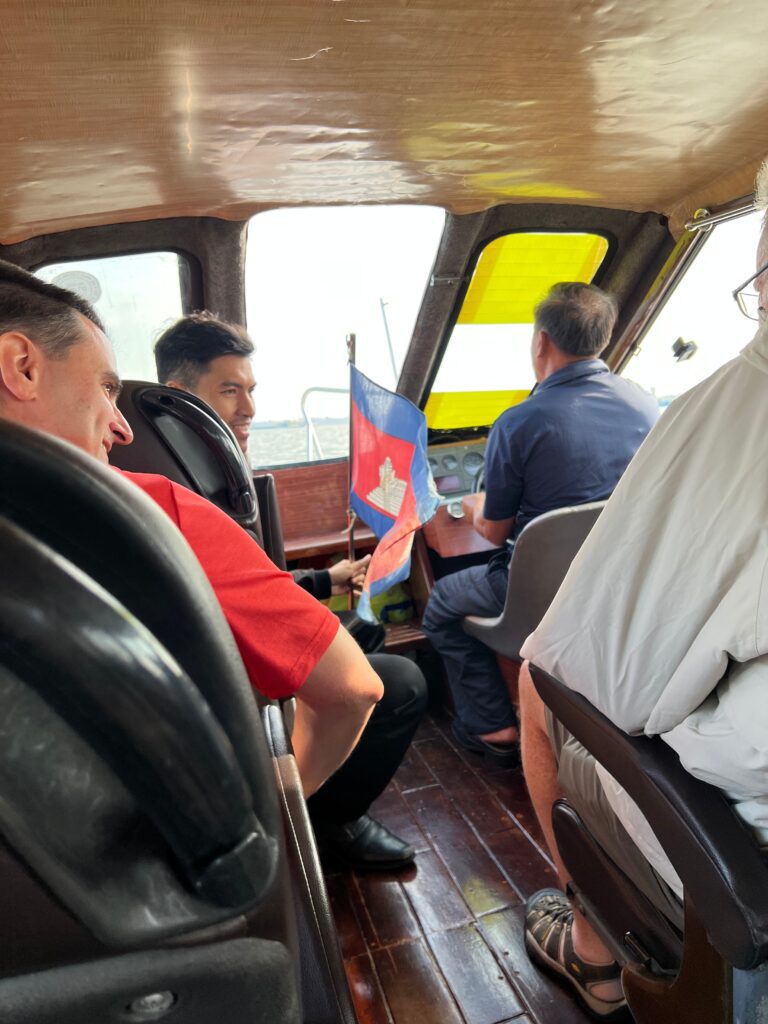
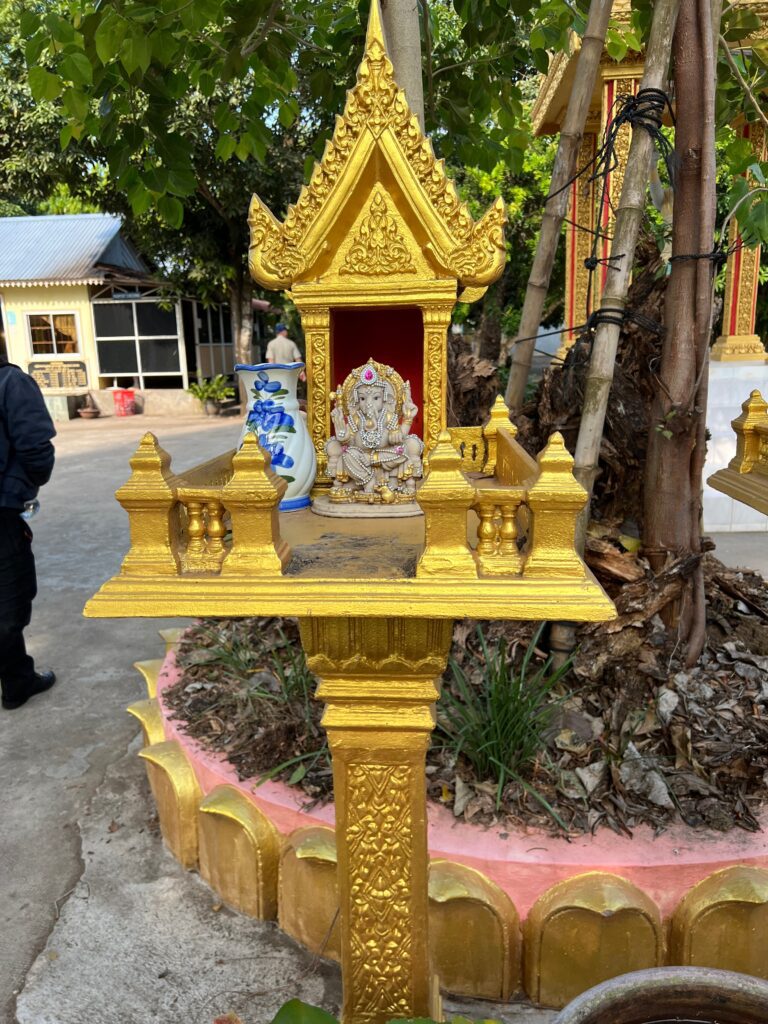

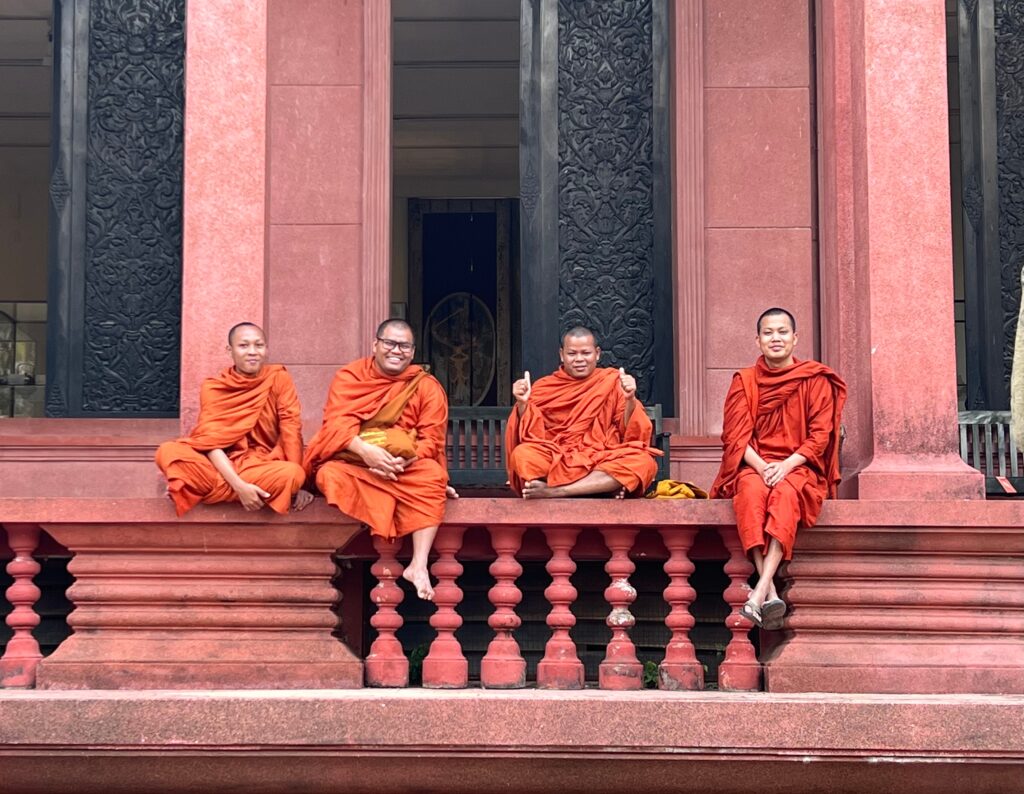
Bike Trip from Vietnam to Cambodia – Kampong Thom
After breakfast and a short van ride to the edge of the city, we mounted our bikes and were off! The first part of the ride was a harrowing trip down pothole-ridden, busy roads that we had to share with cars, trucks, and scooters. The roads soon became paved, but we had to go through a scary area with lots of construction and huge dump trucks.
We finally made it out of the city and onto long, straight, paved roads that took us through lotus fields on one side and rice paddies on the other. After this stretch of road, we entered one village after the other. We detoured to a school that was in session, and the uniformed kids got a kick out of us-especially Sam and Sammies shared ride!
Snacks!
The van followed us whenever possible, and would stop every couple of hours to feed us. Each time, they set up a folding table with various fruits, candy bars, chips, and drinks. Our favorite was the mangosteen, AKA “the Queen’s Fruit.” If you have never had mangosteen and you see it somewhere, I highly recommend trying it! It is difficult to find in the US because it needs a very hot, humid environment and has a short period of ripeness. When ripe, the fruit is purple-brown, with a hard thick shell and a crown that looks like a flower. It is cracked open to reveal numerous white fruit segments, which are juicy and sweet. There is usually at least one seed, so be careful.
Our team always provided fruit, water, a variety of sodas, and taro chips. We stopped by the river in a village and made friends with some local kids, who shared our snacks. Then, we made friends with monks at a monastery who let us use their toilet. We brought protein bars but never ate them- we rarely got hungry!
The Ride
We rode through many villages, and the inhabitants were always friendly and seemed happy to see us. Several allowed us to use their private restrooms which were always clean. Pro tip- always travel with tissue and a ziplock bag in Asia. There is usually no TP, and there is not always a trash can. There is usually, however, a “bidet,” which in this setting is a hose with a spray nozzle. The water is usually cold, so prepare for a shock!
The endless lotus fields were delightful! The flowers were pink and huge! The Khmer, or Cambodian, people use lotus blossoms for many purposes in their food, worship, and decoration.
Our ride took us through farmlands, where we saw buffalo, cows, and goats. At one point, a particularly vocal calf ran along with us. Hilarious! In one village, we actually saw a guy training his roosters for a cock fight!
The Ancient City of Oudong
After lunch, we started on my favorite part of today’s ride. This was a red dirt road through a verdant green jungle. We could see the stupas of Oudong on a distant hill over the waves of green. After riding bikes for a while, and a short ride in the van, we reached the village of Oudong, which was at the base of the hill containing the stupas. Oudong was the capital of Cambodia for many years until one king moved it to Phnom Penh. The town contains a huge wet market, where we saw unique snacks including baby frogs, stuffed frogs, crickets, ants, and honeycombs with bee larvae. No tarantulas!
The stupas we saw from the distance were on top of a huge hill. We climbed the old staircase up to see the older stupas. A few more stairs took us to the newer, clean white stupa decorated with elephants and boasting stunning views of the surrounding areas. Numerous temples and monasteries dotted the green landscape as far as the eye could see.
We walked downstairs to see the Hall of 1000 Buddhas, which reminded me of a discount Buddha warehouse, like one of those going-out-of-business mall stores. Here, we received a traditional Buddhist blessing from a monk.
The walk down the mountain was via a newer set of stairs and was much easier. The stairs were flanked by two koi ponds which were guarded by a troop of macaque monkeys! They are always funny but beware! They can be aggressive and will bite you to get your snacks!
You can visit Oudong as a day trip from Phnom Penh. Hire a private driver or take a bus. It is well worth the trip.
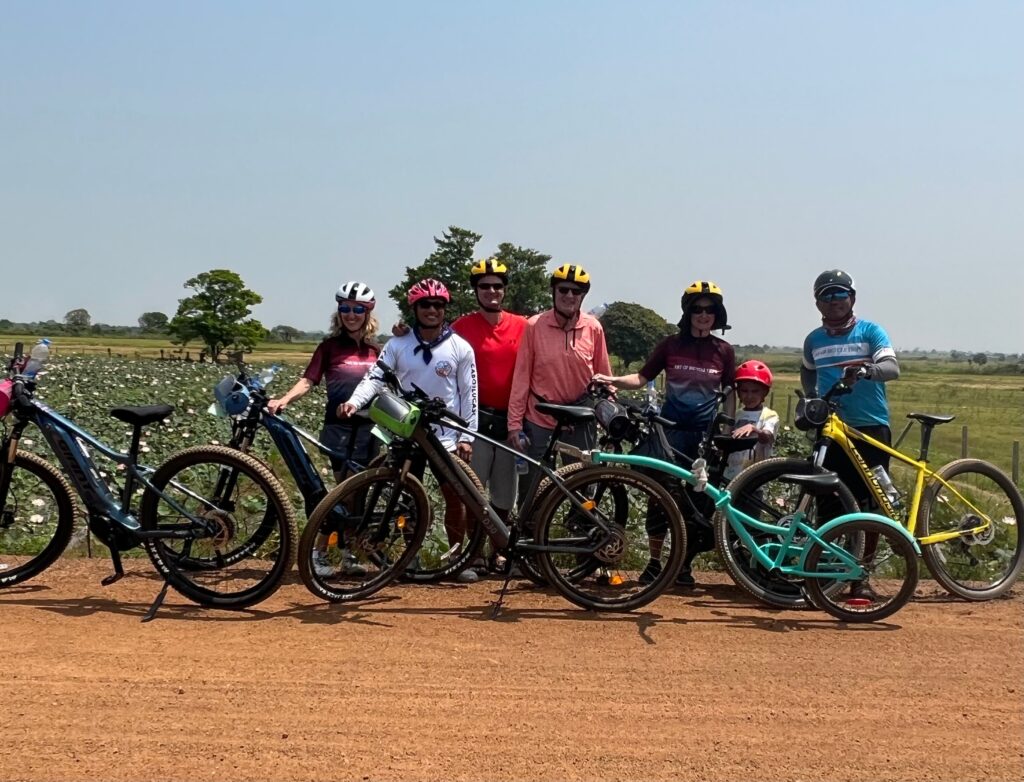

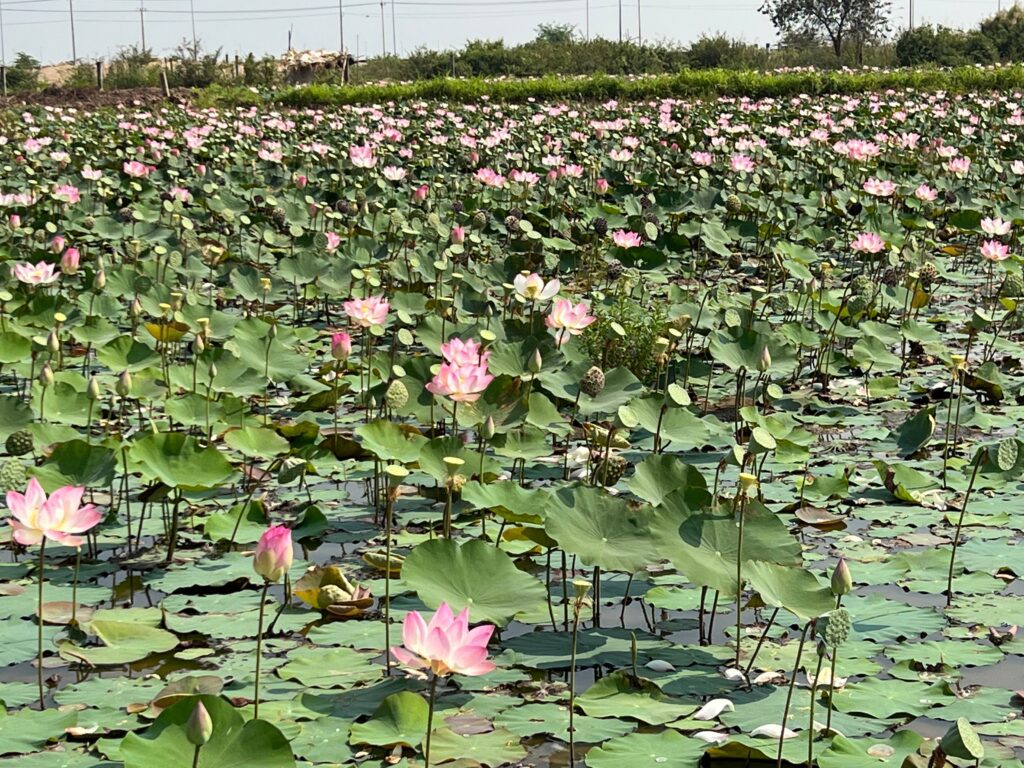
Sambor Village
This quaint resort sits around the halfway point between Phnom Penh and Siem Reap. It consists of several freestanding villas connected by a series of paths shaded by trees and lined by fairy lights. An ethereal pool adorns the entryway, and the heart of the resort is a two-story, open-air reception area and restaurant. We had a nice dinner here, the usual multi-dish, family-style meal of various meats and vegetables.
The rooms were simple but nice, and contained all the basic items you would need. The decor was plain, but the bed was comfortable and the water warm enough.
Sambor Prei Kuk
A portion of our bike ride was along a two-lane paved road with full-size vehicles. It was not very busy and I was still pretty comfortable. Eventually, we arrived at the entrance to Sambor Prei Kuk, which is an ancient city of temples that has been nearly reclaimed by the forest. We rode our bikes down sandy forest trails from temple to temple, enjoying the smells and sounds of fallen leaves as we explored like inquisitive children.
This UNESCO World Heritage Site was the ancient village of Ishanapura. This pre-Angkorian town was the capital of the Chenla Empire in the 5th and 6th centuries and is composed of over 100 temples. There were active archaeological digs where history is still being uncovered.
After our time exploring this area, we stopped at a roadside stand for sticky rice prepared inside of a bamboo reed.
Spider Village
We had heard that they eat spiders in Cambodia. It seems creepy and weird, but when you hear how this started, you will understand. The Khmer Rouge was a group of Cambodian Communists who came to power in the mid-1970s. The Cambodian people are known as “Khmer” and the word “Rouge” is French for red. Red is the color of the communist party. The leader of the Khmer Rouge, Pol Pot, was basically Cambodian Hitler and was responsible for the autogenocide of the Cambodian people.
This brutal regime tortured and murdered millions of its own people. They killed the educated people marched everyone else into the countryside and made them farm. Many of these people had no farming skills and were starving.
A village called Skuon contained a massive population of tarantulas. You eat what you have access to, and eventually, the starving would-be farmers learned to catch, prepare, and eat this abundant resource. This is likely why the Khmer people also eat so many different types of critters.
We stopped at a large roadside market where tourists can sample this local snack and, if you are unlucky, meet a live one! Sammy enjoyed this part, but oh no not I!
Women carried platters heaped high with spider carcasses, deep fried and flavored with herbs and spices. We each plucked off a leg and ate it up! It was nicely flavored and had a hefty crunch. Not bad! We saved the body for our driver, though. We didn’t want to be greedy!
Bike Trip from Vietnam to Cambodia – Siem Reap
After a very long 3-4 hours in the van, we finally arrived at our hotel in Siem Reap. The Raffles Grand d’Angkor was even nicer than the other hotels we had stayed at. The staff fawned all over us, offering drinks and presenting us with commemorative scarves to thank us for our patronage. The service was amazing, but just a bit over the top, almost to the point of being uncomfortable.
The rooms were perfect, fully equipped, and luxurious. This is a great base of operations for Siem Reap! Highly recommend it; however, I am sure there are very nice places that can be had at a more reasonable price. We don’t really know how much the rooms cost, since they were included in the tour and the company probably negotiates rates. According to hotels.com, the rack rate for a standard room is around $500.
The Chanrey Tree
Dean’s birthday was coming up, so we took tuk-tuks from our hotel to the Chanrey Tree. Tuk Tuks in Cambodia are much like the ones in Thailand- little motorized, open-air vehicles, pimped out in a variety of ways.
This was one of the best meals we had, although all of the food was delicious, if a little repetitive. We were here on our own and got to choose our own dishes. Since we had not tried the really exotic snacks at Oudong village, we had chicken with ants and stuffed frogs. The frogs were delicious! The chicken was good, but we really couldn’t taste the ants. they were more of a garnish than a significant part of the dish. I did notice little ant body segments stuck in my teeth later. The ambiance of the restaurant was nice, and the service was excellent.
There was a huge festival going on across from the hotel, but we were beat so we turned in after dinner. We had an early start the next day!
Bike Trip from Vietnam to Cambodia – Angkor Wat and Angkor Thom
Angkor Wat
The last day of our bike trip from Vietnam to Cambodia began with a very early wake-up call and pick-up. Art and our driver collected us at 5 am and we drove to Angkor Wat. Finally, the apex of our journey was here! We drove for what seemed like forever, and I anxiously craned my neck to see, expecting to see the towers appear over every patch of trees, around every corner.
The Angkor complex consists of two parts- Angkor Thom is the “Temple City” and Angkor Wat is the “Temple Complex.” It is the largest religious structure in the world and an impressive display of Khmer architecture.
When Angkor Wat finally came into view, it did not disappoint. At this time, it was visible in silhouette, its 5 towers looming over its moat. The towers are meant to resemble lotus blossoms, pointing out just how important the lotus has always been to the Khmer people. The temple was originally built as a Hindu structure and meant to resemble Mount Meru, but a later king covered it to a Buddhist site. In Hindu culture, Mount Meru is the center of the universe, but it is not clear exactly where on earth it is.
Sunrise
We hopped out of the van and started to walk across the lawn leading up to the temple. A line of people flanked the moat, waiting for that Instagram shot of the sun rising over the temple with a reflection in the water. It is a good idea to see the temple at sunrise or sunset.
People were friendly and were very polite about taking turns at having the million-dollar view. We hung around on the right side of the bridge for a while, taking pix and basking in the otherworldly beauty of the place.
We migrated over to the left side of the bridge, which was less crowded. This is where you get the shot of the sun perfectly behind one of the towers, resulting in a gorgeous orange glow. It truly was a surreal experience.
After numerous photos, the temple opened to the public and we went inside. There were numerous temples and statues, walkways, and retaining pools. Most of the walls contained bas-relief carvings.
We took Sammy and Dean back to the hotel, had breakfast, and hopped on our bikes for a whimsical, wonderful tour of Angkor Thom!
Angkor Thom
This portion of the bike was not well-suited for Sammy’s trailer, so we left him back at the hotel with Dean, to enjoy some pool time and relaxation. Art led the four of us through town and into the forest which concealed hundreds of temples comprising Angkor Thom, the Temple City. We rode far faster than I was comfortable, sliding around hairpin turns in the sand, narrowly missing trees, and jumping over roots.
Highlights included the west gate, which few people ever see. We drove down a path next to the river, saw a few small ruins, and then a face became visible through the trees! It was strange and mysterious. This image is featured throughout the temple city, and I found it interesting, intriguing, and a bit whimsical.
There are five gates to Angkor Thom: North, South, East, West, and the Victory Gate. The South Gate is the largest and is flanked by nagas, whose fighting caused “the churning of the milky sea,” which, in Hindu mythology, is a sort of battle between good and evil that resulted in creation, to my understanding. The East Gate is the gate of the dead. The South and East gates have large arches through which you enter the city, and they are grand entrances.
Bayon
The true highlight of Angkor Thom, for me, was Bayon. This is the central temple of Angkor Thom and is unique among all the temples I have ever seen because of the serene faces smiling on every surface! They really do impart a sense of peace and tranquility. We explored this massive temple for a while and got some great photos of ourselves and orange-clad monks which contrasted nicely against the grays of the facade.
During our snack break, we observed the monks carrying out their daily duties, such as buying cell phone chargers from a vendor and taking selfies in front of the temple.
We kept riding through the tranquil forest until we reached Ta Prohm. This may be the second most famous temple in the area (second to Angkor Wat itself). It was featured in Lara Croft, Tomb Raider, and is very cool- fig and banyan trees are growing into the temple and reclaiming the stone, resulting in very artistic images and adding an extra layer of mystery. One set of roots looked like dinosaur claws, grabbing the stone to pull it back to the earth.
Because we were riding from temple to temple in the woods, we almost felt like we were discovering them ourselves! What a great way to explore the area. If you get a chance, DO THIS!!
This was the best day of the entire bike trip! What a way to finish. Art was an amazing guide, and Art of Bicycle Trips did a great job in handling every single detail and orchestrating this massive trip.
The Butterfly Pea
Our last dinner together was a sumptuous, multi-course affair at the Butterfly Pea. The food and presentation were on point! This is the perfect place to celebrate a special occasion.



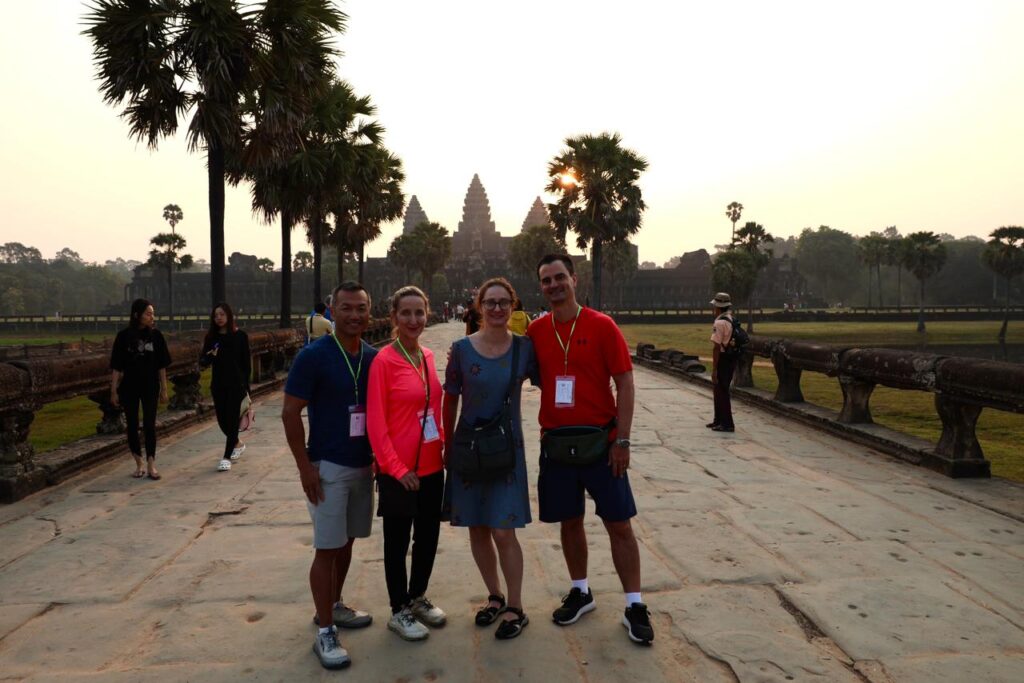
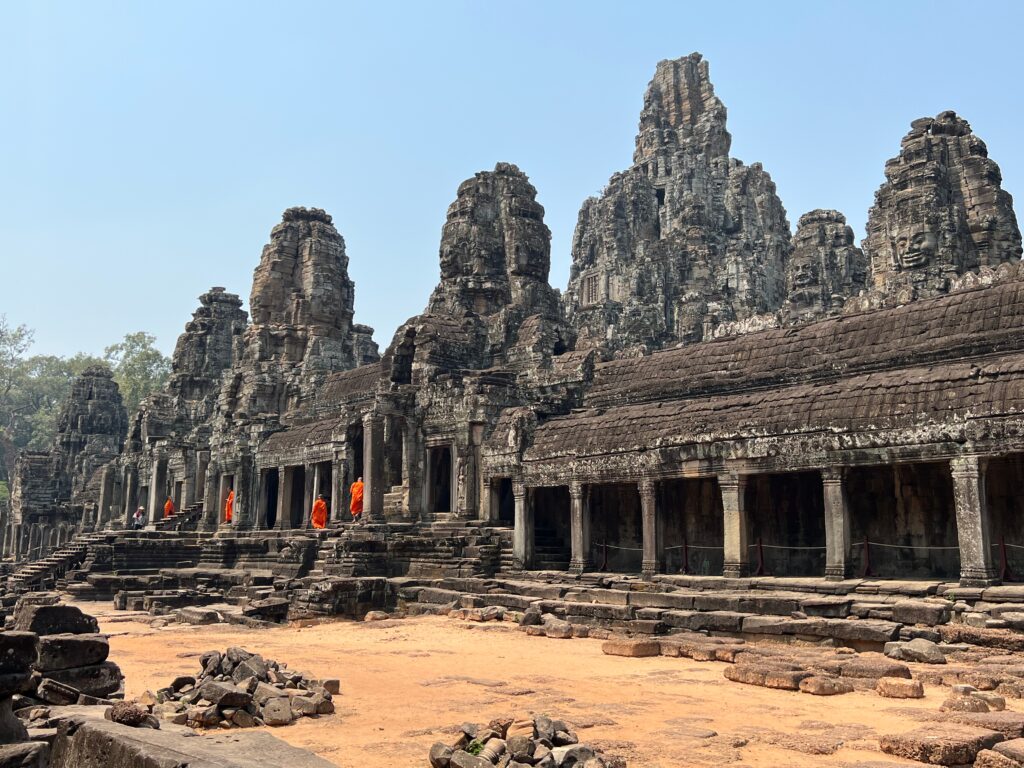
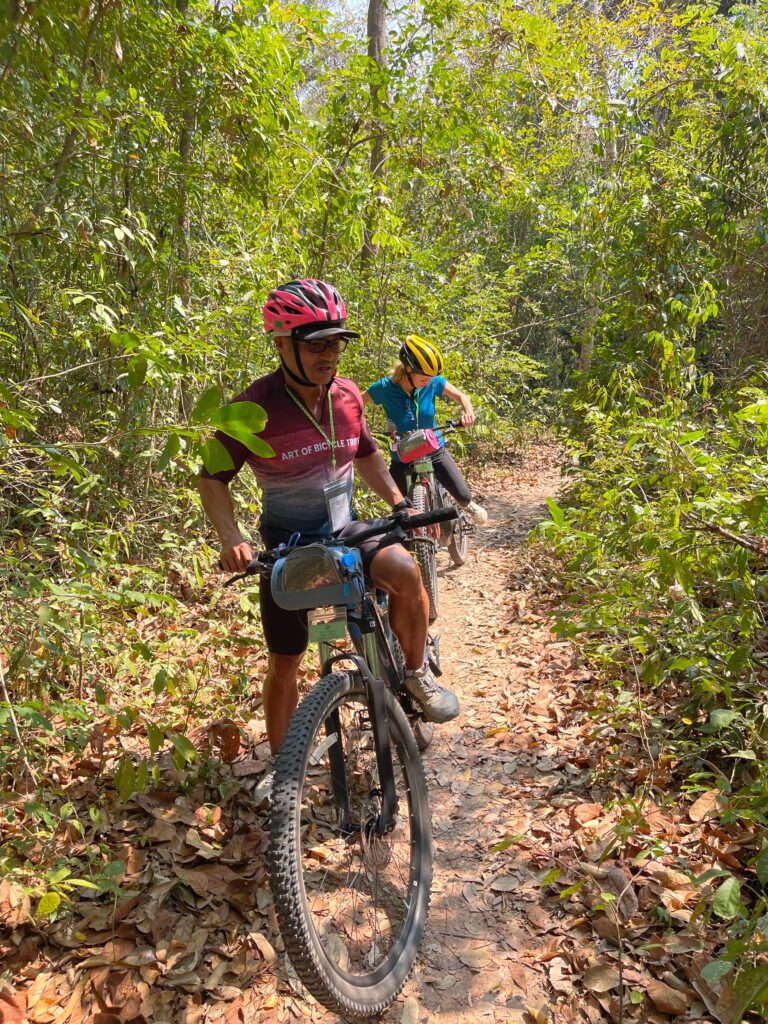
An (ALMOST) Disastrous Ending
A word to the wise- check your documents. We had to get 2 Vietnam e-visas before the trip because the only type available for American citizens at the time were 30-day single-entry e-visas. We entered the country twice. The process was quick and easy, and we had our visas within 3 days. I thought I checked them thoroughly, but when we showed up at the airport, the gate agent informed me that the passport number on my visa was off by one number. They would not let me fly! Vietnam is VERY strict about whom they let into their country.
This was when Ly at Art of Bicycle Trips really came through. Mind you, our trip with Art of Bicycle Trips was over. She did not have to help me. She was able to get a new e-visa and a new plane ticket for me to get to Dong Hoi for the next leg of our trip. Art would not leave my side until everything was in place.
Vuong went ahead to Vietnam, so we did not have to buy two new plane tickets, and Art drove me back to the hotel. Vuong had a rough night sleeping in the Ho Chi Minh City Airport, and I had a rough night back in the hotel (nervous stomach). But, in the end, I made it to Phong Nha where Vuong and I reunited and we rested up for the next leg of this epic adventure!
Until Next Time…
What did you think about our bike trip from Vietnam to Cambodia? When will you contact Art of Bicycle Trips to schedule your trip?? Comment below!
Stay tuned until next month! Read about our Journey to the Center of the Earth with Oxalis Adventures, as we descend into the largest cave in the world, Hang Son Doong!

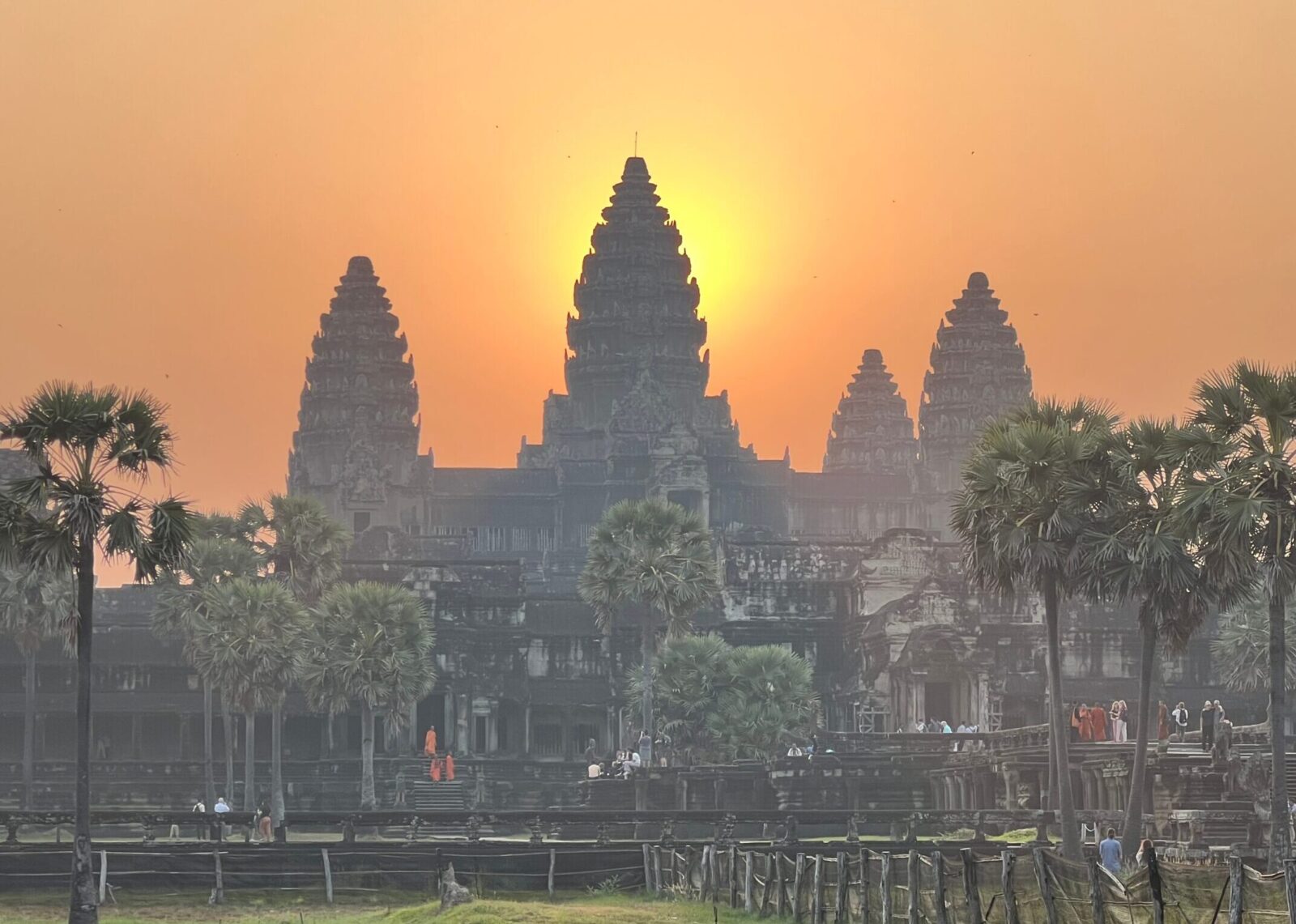
Already planning our next bike tour with them! Love this company!!!
How did the sizing for the jerseys run? Did you have the option to exchange if wrong size ordered? Loved the blog!
Jeanie- Sorry for the delay! Had to find my jersey so I could answer you accurately. The jerseys do run a bit small, but it was not a problem for us to size up on the trip. Are you thinking of doing a tour with Art of Bicycles? Thanks for reading!